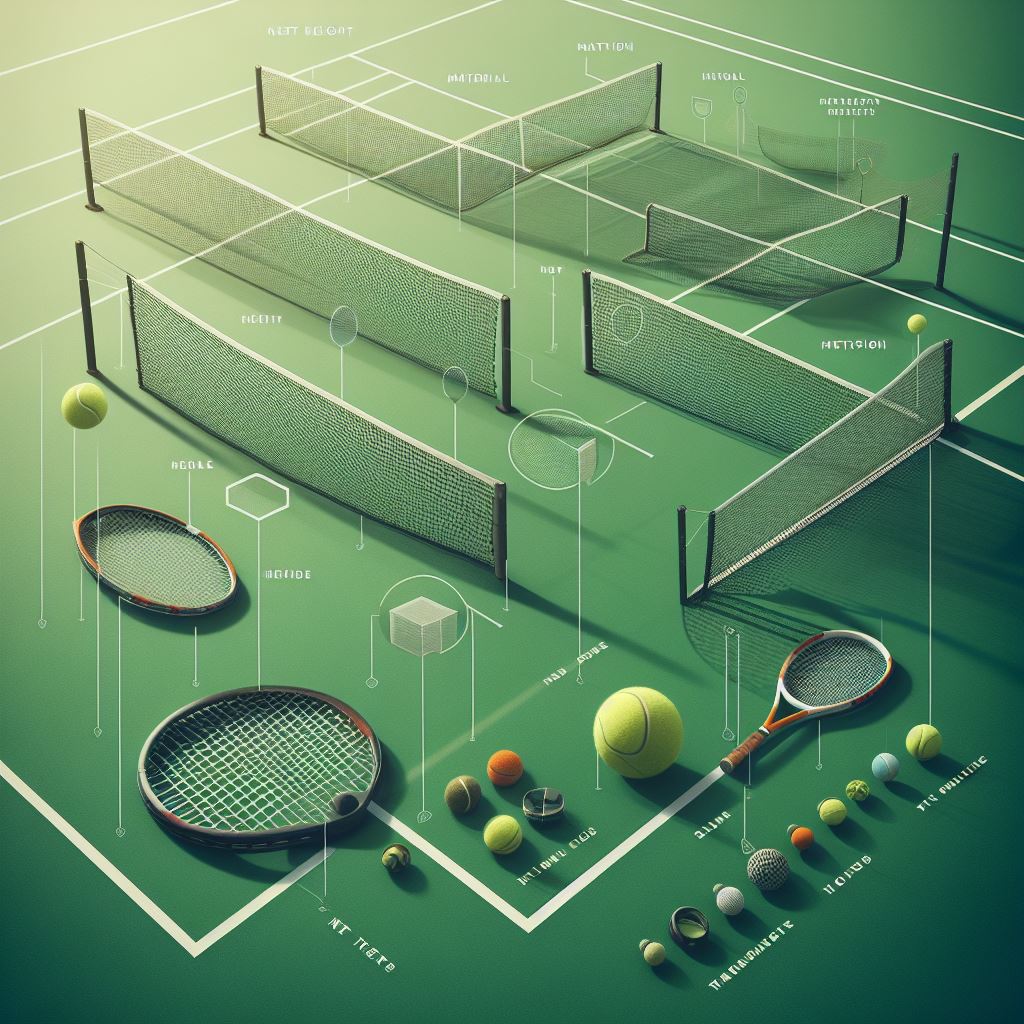Dive into the world of tennis, where the court becomes a canvas for exhilarating battles of skill and strategy. Like a symphony of athleticism, this timeless sport combines grace, power, and finesse.
In this comprehensive guide, we will explore the basics and rules that govern the game. From the dimensions of the court to the intricacies of scoring, serving, and shot techniques, prepare to immerse yourself in the captivating world of tennis.
Key Takeaways
- Tennis courts have standard dimensions and are divided into different areas.
- Racquets and balls are essential equipment for playing tennis.
- The scoring system in tennis involves winning sets and tiebreakers.
- The serve and return are crucial aspects of the game.
The Court and Equipment
The tennis court and its accompanying equipment form the foundation for the game of tennis. Understanding the dimensions and layout of the court is crucial for players to strategize and execute their shots effectively.
A standard tennis court is 78 feet long and 27 feet wide for singles matches, while for doubles matches, it is 78 feet long and 36 feet wide. The court is divided into two equal halves by a net, which stands 3 feet high at the center. The net extends across the entire width of the court, measuring 42 feet. The court is further divided by lines into different areas, such as the baseline, service boxes, and alleys.
In addition to the court, players must have the essential tennis equipment: racquets and balls. Tennis racquets come in various sizes and weights, with different types of strings to suit individual playing styles. The racquet’s grip size is also important, as it affects a player’s control and comfort during the game.
Tennis balls are made of rubber and covered in felt. They must be yellow in color and have a diameter of 2.7 inches. The balls should also have consistent bounce and be able to withstand the impact of powerful shots.
Scoring System
Continuing from the previous subtopic, understanding the scoring system in tennis is essential for players to keep track of points and determine the winner of a match. To help you grasp this system, here are three key points to consider:
- Different types of serves: In tennis, the server has two attempts to start the point. The most common serve is the ‘flat’ serve, which is hit with power and speed. Another type is the ‘slice’ serve, which has spin and curves away from the receiver. Lastly, there is the ‘kick’ serve, which has topspin and bounces high, making it challenging to return.
- Strategies for winning a tiebreaker: In some matches, a tiebreaker is played when the set score reaches 6-6. To win a tiebreaker, players must reach seven points, with a margin of at least two points. Strategies include being aggressive with your shots, minimizing unforced errors, and staying mentally focused and composed.
- Winning the match: In order to win a tennis match, players must win the majority of sets. Generally, matches are played as best of three sets for women and best of five sets for men. Each set is won by the player who reaches six games first, with a margin of at least two games. If the score reaches 6-6, a tiebreaker is played to determine the winner of the set.
Serve and Return
To further explore the intricacies of tennis, it is important to delve into the fundamental aspect of serve and return. The serve is the starting point of every point in tennis and mastering the serve technique is essential for success on the court. The serve involves hitting the ball over the net into the opponent’s service box, with the goal of starting the point offensively. Players employ various techniques, such as the flat serve, slice serve, and kick serve, to add variety and keep their opponents guessing.
On the other hand, the return is the receiver’s response to the serve. Return strategies can vary depending on the opponent’s serve and playing style. Players aim to neutralize the server’s advantage and gain control of the point. Strategies may include aggressive returns to put pressure on the server, or defensive returns to focus on consistency and placement. Footwork and timing are crucial in executing an effective return.
Understanding the serve and return aspects of tennis is vital as they set the tone for each point. These skills not only determine the outcome of individual points but also influence the overall flow and momentum of the match. With a strong serve and effective return strategies, players can gain an advantage and dictate the pace of the game.
Now, let’s move on to the next aspect of tennis: groundstrokes and volleys.
Groundstrokes and Volleys
Moving on from the serve and return, we now delve into the essential aspects of groundstrokes and volleys in tennis. Mastering these techniques is crucial for players to excel in the sport. Here are three key points to understand about groundstrokes and volleys:
- Forehand technique: The forehand stroke is one of the most important shots in tennis. It involves hitting the ball with the palm of the hand facing the net, using a swinging motion from the shoulder to generate power and accuracy. Proper footwork and body positioning are essential to execute a successful forehand shot.
- Backhand technique: The backhand stroke is equally important and can be executed in two ways: the one-handed backhand and the two-handed backhand. The one-handed backhand requires players to use their non-dominant hand to stabilize the shot, while the two-handed backhand utilizes both hands on the grip for added control and power.
- Volley technique: Volleys are shots that are hit before the ball bounces on the player’s side of the court. They require quick reflexes and precise hand-eye coordination. Players must position themselves near the net and use a short, compact swing to direct the ball back over the net. Good footwork and anticipation are crucial for successful volley shots.
Rules and Penalties
After mastering groundstrokes and volleys, players must now familiarize themselves with the rules and penalties of tennis. Understanding the rules is crucial for fair play and maintaining the integrity of the game. Tennis follows a set of regulations known as the Code of Conduct, which outlines the behavior expected from players during matches. This code emphasizes sportsmanship, respect for opponents, and adherence to the rules. Violations of the Code of Conduct can result in penalties, such as warnings, point deductions, or even disqualification.
Another important aspect of the rules in tennis is line calls and challenges. Players are responsible for making accurate line calls during a match. However, there may be situations where a player disagrees with the call made by their opponent. In such cases, players can challenge the decision using the Hawk-Eye system or video replay. Each player is allowed a limited number of challenges per set, and if the challenge is successful, they retain the same number of challenges. However, if the challenge is unsuccessful, they lose one of their remaining challenges.
Understanding and adhering to the rules and regulations of tennis is essential for players to compete fairly and enjoy the game. By following the Code of Conduct and making accurate line calls, players can ensure a level playing field and maintain the spirit of sportsmanship.
Frequently Asked Questions
What Are Some Common Strategies and Tactics Used in Tennis Matches?
In tennis matches, players employ various strategies and tactics to gain an advantage over their opponents. These include employing serving techniques to start the point off strongly and making strategic shot selections to control the game.
How Can I Improve My Footwork and Agility on the Tennis Court?
Improving footwork and agility on the tennis court is crucial for success. Incorporating footwork drills and agility training into your practice routine can enhance your movement, speed, and overall performance on the court.
What Are Some Recommended Warm-Up Exercises Before Playing a Tennis Match?
Dynamic stretches and cardio exercises are recommended as warm-up exercises before playing a tennis match. Dynamic stretches help improve flexibility and range of motion, while cardio exercises increase heart rate and blood flow to the muscles, preparing the body for intense physical activity.
Are There Any Specific Rules or Guidelines for Playing Doubles Tennis?
When playing doubles tennis, there are specific rules and guidelines that players must follow. These rules dictate how the game is played and provide strategies and tactics for success on the court.
How Does Weather, Such as Wind or Rain, Affect the Gameplay in Tennis?
Weather, such as wind or rain, can significantly impact the gameplay in tennis. It can affect the trajectory and speed of the ball, making it challenging for players to maintain control. Additionally, different court surfaces, such as clay or grass, can also influence the game.
Conclusion
In conclusion, understanding the basics and rules of tennis is essential for anyone looking to participate in or enjoy the sport. From the dimensions of the court to the scoring system and the techniques involved in serving and returning, there is much to learn.
Additionally, mastering groundstrokes and volleys is crucial for success on the court. These are the primary shots used in rallies and can greatly impact the outcome of a match. Groundstrokes involve hitting the ball after it bounces, while volleys are executed before the ball bounces.
Remember, tennis is a game with a rich history and global following, with over 1 billion fans worldwide. The sport has produced legendary players and iconic matches that have captivated audiences throughout the years. Whether you are a casual player or a dedicated fan, understanding the fundamentals of tennis will enhance your enjoyment and appreciation of the sport.








No Comment! Be the first one.